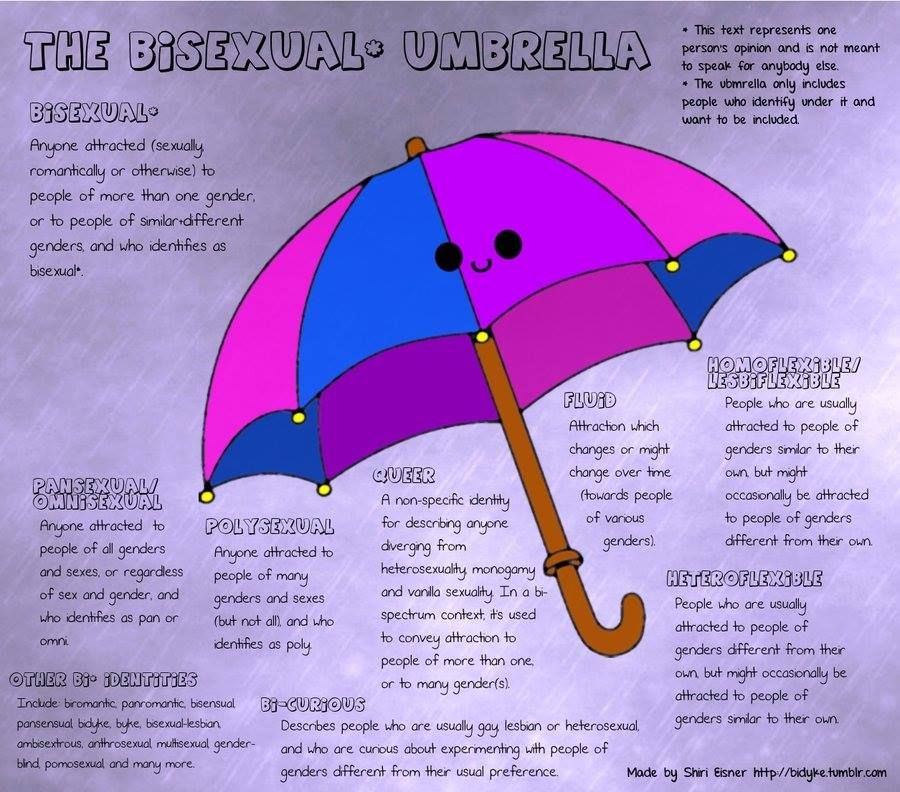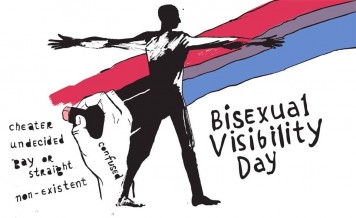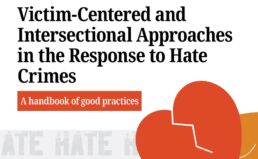September is not only the month of the first yellow leafs on trees and the beginning of school; September is the month of Bisexuality Visibility Day and Bi-Sexuality Awareness Week! Let’s go a bit more in depth into the topic and discover more about these two very important events within the LGBT* agenda.
What is Bisexuality?
Many are the definition of bisexuality. Today, the main interpretation of the word “bisexual” tends to refer to an umbrella term, including many other sexual orientation and expressions such as bisexual, pansexual, omnisexual, bi-curious, queer, polysexual, fluid, homo-flexible and so on… The definition of “bisexual” I like the most is the one created by bisexual activist and writer Robyn Ochs. The reason I like that is that her definition does not intend bisexuality in derogatory terms.
Ochs states “I call myself bisexual because I acknowledge that I have in myself the potential to be attracted – romantically and/or sexually – to people of more than one sex and/or gender, not necessarily at the same time, not necessarily in the same way, and not necessarily to the same degree”. This definition is inclusive towards any gender identity and sexual orientation and allows the individual to identify as bisexual without the need to follow rigid behavior dogmas.
However, interpretations of the term “bisexuality” are many and the debate is actually a matter of discussion even at present time within the LGBT* community.
What are Bisexuality Visibility Day and Bi-Sexuality Awareness Week?
Bisexuality Awareness Week starts on the 21st of September and ends few days later on the 26th. Right in the middle of the week, on the 23rd, takes instead place Bi-Visibility Day.
Both the events aim at:
- Raising awareness on bisexuality
- Promoting visibility of bisexuality
- Empowering the bisexual community
- Fostering cultural acceptance at different levels (within society, institutions, local and national government)
- Fighting the many prejudices and stigmas targeting bisexual people
To reach these goals, workshops, conferences and social campaigns are organized in many countries around the world.
History on Bisexuality Visibility Day has been quite recent. The day was celebrated for the first time in the United States of America thanks to the initiative of three activists: Gigi Raven Wilbur, Michael Page and Wendy Curry, respectively coming from Maine, Texas and Florida.
Page was the one who, one year before the celebration, designed the tri-colored flag that later became the symbol of the bisexual community around the world. Today, pink, purple and blue define the colors of bisexuality pride: pink stands for same-sex attractions, blue regards heterosexual attractions and purple represents the blend of the two. That blend symbolizes romantic and/or sexual attraction for more than one gender.
 Fighting Bisexuality Erasure and Prejudices
Fighting Bisexuality Erasure and Prejudices
Bisexuality erasure occurs at present time both inside and outside the LGBT* community. Mass media significantly contributed to exacerbate this issue. Precisely, the term “bisexuality erasure” refers to the tendency to wrongly define, falsify and deliberately remove references to bisexuality in various fields, from bisexuality history to media events and other sources. This has obviously repercussions within the legal system and in the general discourse at society’s level, where the discourse on bisexuality is basically inexistent and soaked of prejudices.
Why does this happen? The cause might be attributed as a manifestation of biphobia, but not necessarily. Often this behavior is dictated by a widespread poor knowledge of bisexuality as a romantic and sexual orientation. And what happens to not be erased from media, generally arrives to the general public quite distorted. The result is that bisexual boys are generally perceived as closeted gays and bisexual girls tend to be believed as straight girls who like to play the bisexuality card to appease the sexual fantasies of their men. What about bisexual trans, intersex, genderqueer, agender and asexual people? They are generally not even taken into consideration since already representing one letter of the spectrum seem to be enough from a heteronormative perspective.
These beliefs go hand by hand with prejudices and stigmas considering bisexual people as promiscuous, cheaters, slutty, greedy and without any sense of decency and self-respect. With even some natural predisposition to threesomes and orgies.
However, it is important not to undervalue the fact that bisexual erasure occurs also within the LGBT* community. This might stem from the belief that the bisexual community does not deserve equal status within the community since bisexual people can easily enjoy their “straight privilege” within society.
That is the reason why it is so important to raise more awareness on bisexuality, both inside and outside the community. And to celebrate, because bisexual people deserve to feel equally proud of who they are too.
Happy Bi-Visibility Day to everybody.
Written by Alice Michelini
Sources:
Robyn Ochs, editor of the Bisexual Resource Guide
Violet Carson, History of Bisexuality, 2014
Photo Courtesy of Shiri Eisner and Mayina Mukhammadjanova




